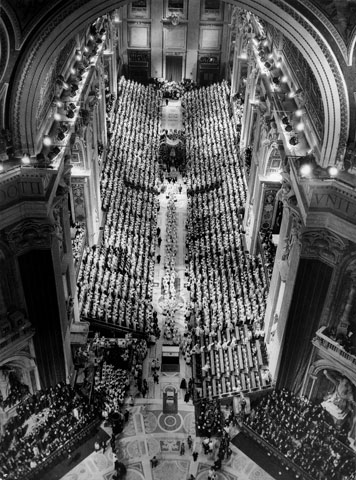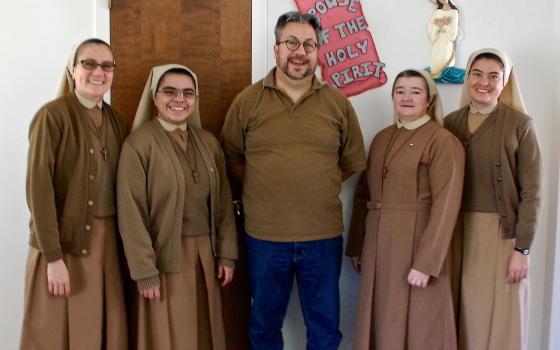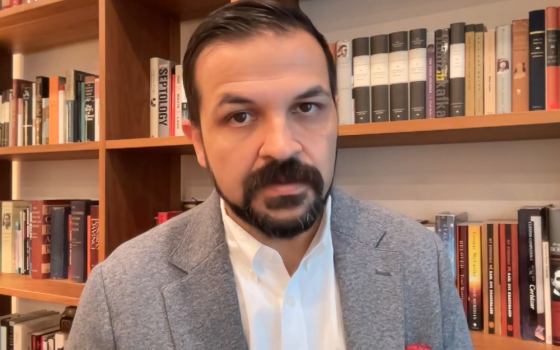
Bishops of the world line the main aisle of St. Peter's Basilica during the opening session of the Second Vatican Council in 1962. (CNS file photo)
When the Second Vatican Council ended on Dec. 8, 1965, Pope John XXIII, who convened the council in 1962, had died. A new pope, Paul VI, with more traditional views, had been elected. The council had gained notoriety for its heated debates and for having produced more lines of text than any of the other 20 previous councils -- 32 percent of the total. Besides being wordy, the text was often contradictory and difficult to understand. Fifty years later, the documents are still debated, as can be seen in the seven books discussed here.
Called a “gentle revolutionary,” John XXIII was not a typical pope, nor was he a typical revolutionary. Born near the Italian Alps, Angelo Giuseppe Roncalli (1881-1963) was the son of a sharecropper. He joined the priesthood at an early age and rose to become a papal diplomat in Bulgaria, Turkey and France, and later, a patriarch of Venice. He was elected pope in 1958, and because of his age was seen as a caretaker pope -- good for a few years until someone younger and better suited came along.
 THE GOOD POPE: JOHN XXIII & VATICAN II: THE MAKING OF A SAINT AND THE REMAKING OF THE CHURCH
THE GOOD POPE: JOHN XXIII & VATICAN II: THE MAKING OF A SAINT AND THE REMAKING OF THE CHURCH
By Greg Tobin
Published by HarperOne, $26.99
But his abilities were seriously underestimated, as can be seen in Greg Tobin’s biography, The Good Pope. The book offers an engaging profile of the man who convened the 21st ecumenical council, which, depending on one’s interpretation, either threatened centuries of Roman Catholic tradition or enlightened them.
 VATICAN II: THE BATTLE FOR MEANING
VATICAN II: THE BATTLE FOR MEANING
By Massimo Faggioli
Published by Paulist Press, $14.95
Some considered the council to be blessed by the Holy Spirit. Others, like the French Archbishop Marcel Lefebvre, thought the council was the work of Satan. In Vatican II: The Battle for Meaning, Massimo Faggioli offers a hard-hitting study of the battles that took place during the council.
The council had barely begun when, on Oct. 30, 1962, dissension broke out. The conservative Cardinal Alfredo Ottaviani protested a draft of a document concerning changes to the Mass. He asked, “Are we dealing here with a revolution regarding the whole Mass?” He listed his complaints, causing his speech to run over the time allotted. When he was cut off, something almost unheard of happened: “The assembly broke out in applause.”
Although traditionalists, as Faggioli shows, were a minority, they wielded great power and could count among their members the Roman Curia. Some traditionalists thought the council agenda was wrong to the point of being heretical. Lefebvre, for example, believed that when Paul VI promulgated the documents of Vatican II, he had ceased to be pope because his actions had been schismatic; the cardinals he appointed were therefore invalidly appointed. Others opposed the council but professed allegiance to the pope and to the bishops while fighting for a pre-Vatican II church.
 VATICAN II: THE ESSENTIAL TEXTS
VATICAN II: THE ESSENTIAL TEXTS
Edited by Norman Tanner, SJ
Published by Image Books, $19
In Vatican II: The Essential Texts, Jesuit Fr. Norman Tanner edits the council documents and frames each with a brief but informative overview by Edward Hahnenberg, author and professor of theology. The book opens with two essays offering opposing perspectives that set up the lines of argument emanating from council documents. Author James Carroll writes from the perspective of one who believes that the work of the council was to dismantle the last divine right monarchy and achieve a needed break with the past. Pope Benedict XVI, who takes the opposing view, sees the dissent regarding the council as one of hermeneutics (interpretation) and believes that the council called for renewal, not revolt.
 KEYS TO THE COUNCIL: UNLOCKING THE TEACHING OF VATICAN II
KEYS TO THE COUNCIL: UNLOCKING THE TEACHING OF VATICAN II
By Richard Gaillardetz and Catherine E. Clifford
Published by Liturgical Press, $19.95
Despite the debates about Vatican II, few people knew what really happened during the council. Partly it was because of the secrecy surrounding it. But also, as explained in Richard Gaillardetz and Catherine E. Clifford’s Keys to the Council, it was difficult to understand such a large body of material dealing with thorny theological and philosophical issues. Paul VI increased the difficulty by allowing opposing sides to add their varying views to the documents, which tended to obfuscate their meaning. Shortly after the council ended, its major documents were published. This was followed by a flood of interpretations trying to explain what the documents actually meant.
Even the press releases concerning the council were difficult to follow. As Tobin mentions, a London periodical complained of “English so peculiarly outrageous that one hardly knows whether to laugh or cry.”
 VATICAN II: FIFTY YEARS OF EVOLUTION AND REVOLUTION IN THE CATHOLIC CHURCH
VATICAN II: FIFTY YEARS OF EVOLUTION AND REVOLUTION IN THE CATHOLIC CHURCH
By Margaret Lavin
Published by Novalis, $18.95
In Vatican II: Fifty Years of Evolution and Revolution in the Catholic Church, professor of theology Margaret Lavin offers an accessible, coherent look at the council. She explains the impetus behind the council, presents an overview of its documents, and then looks at their history, major themes and challenges.
 CHRIST, CHURCH, MANKIND: THE SPIRIT OF VATICAN II ACCORDING TO POPE JOHN PAUL II
CHRIST, CHURCH, MANKIND: THE SPIRIT OF VATICAN II ACCORDING TO POPE JOHN PAUL II
Edited by Zdzislaw Josef Kijas, OFM Cap, and Andrzej Dobrzynski
Published by Paulist Press, $15.95
Scholars worked to achieve a consensus in interpreting the documents, but as these books show, conflicts still exist. Some, for example, see John Paul II’s papacy as one that attempted to curb the agenda of Vatican II. Others, like journalist Michael Novak, believe that John Paul, with his awareness of the presence of the Holy Spirit, rescued the council. The book Christ, Church, Mankind notes John Paul’s ardent passion for Jesus Christ and his efforts to spread that passion as part of the vision of Vatican II. Based on a 2008 international assembly that studied his pontificate and its connection to Vatican II, the book points out that Karol Wojtyla’s beliefs about the family, women and motherhood positively influenced council documents. But it says little about the council’s particulars.
V ATICAN II: FIFTY PERSONAL STORIES
ATICAN II: FIFTY PERSONAL STORIES
Edited by William Madges and Michael J. Daley
Published by Orbis Books, $28
Dennis Doyle’s foreword to Vatican II: Fifty Personal Stories offers an insightful, clearly written “interpretive introduction” to Vatican II and to the 50 memoirs collected here. In one especially engaging memoir, Redemptorist Fr. Francis Xavier Murphy recounts using the pseudonym Xavier Rynne to protect himself from the Roman Curia, so he could cover the council for The New Yorker and let the world in on the council’s secrets. In another, Fr. Joseph Komonchak, professor emeritus of theology and religious studies at The Catholic University of America, notes somewhat wistfully that many of those involved in the tense drama of the council are deceased, while most Catholics today wonder what the fuss was about.
Was the council a power struggle between conservatives and liberals? Or were both sides trying to be faithful to the authentic and apostolic church as they understood it to be? These books offer no definitive answers to the questions. But after reading them, one can say that despite -- or because of -- being guided by the Holy Spirit, the council created such dissension that the church is still reeling from it.
Who would have thought that the approximately 2,500 bishops and cardinals who debated, wrote, revised and promulgated the documents of the 21st ecumenical council (as well as the good pope who convened it) could start a fight like the one that’s going on in the church today? Who indeed?
[Diane Scharper is a member of the National Book Critics Circle. Her most recent book is Reading Lips and Other Ways to Overcome a Disability.]



